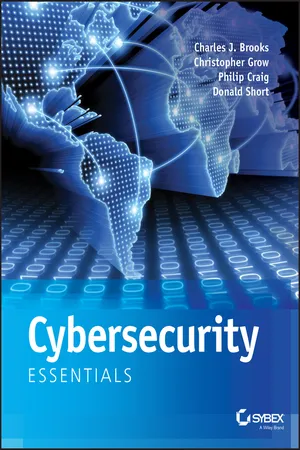
- English
- ePUB (mobile friendly)
- Available on iOS & Android
Cybersecurity Essentials
About this book
An accessible introduction to cybersecurity concepts and practices
Cybersecurity Essentials provides a comprehensive introduction to the field, with expert coverage of essential topics required for entry-level cybersecurity certifications. An effective defense consists of four distinct challenges: securing the infrastructure, securing devices, securing local networks, and securing the perimeter. Overcoming these challenges requires a detailed understanding of the concepts and practices within each realm. This book covers each challenge individually for greater depth of information, with real-world scenarios that show what vulnerabilities look like in everyday computing scenarios. Each part concludes with a summary of key concepts, review questions, and hands-on exercises, allowing you to test your understanding while exercising your new critical skills.
Cybersecurity jobs range from basic configuration to advanced systems analysis and defense assessment. This book provides the foundational information you need to understand the basics of the field, identify your place within it, and start down the security certification path.
- Learn security and surveillance fundamentals
- Secure and protect remote access and devices
- Understand network topologies, protocols, and strategies
- Identify threats and mount an effective defense
Cybersecurity Essentials gives you the building blocks for an entry level security certification and provides a foundation of cybersecurity knowledge
Frequently asked questions
- Essential is ideal for learners and professionals who enjoy exploring a wide range of subjects. Access the Essential Library with 800,000+ trusted titles and best-sellers across business, personal growth, and the humanities. Includes unlimited reading time and Standard Read Aloud voice.
- Complete: Perfect for advanced learners and researchers needing full, unrestricted access. Unlock 1.4M+ books across hundreds of subjects, including academic and specialized titles. The Complete Plan also includes advanced features like Premium Read Aloud and Research Assistant.
Please note we cannot support devices running on iOS 13 and Android 7 or earlier. Learn more about using the app.
Information
PART I
Securing the Infrastructure
| Chapter 1 | Infrastructure Security in the Real World |
| Chapter 2 | Understanding Access Control and Monitoring Systems |
| Chapter 3 | Understanding Video Surveillance Systems |
| Chapter 4 | Understanding Intrusion Detection and Reporting Systems |
| Chapter 5 | Infrastructure Security: Review Questions & Hands-On Exercises |
CHAPTER 1
Infrastructure Security in the Real World
- Understand the relevance of infrastructure security
- Describe the functions, categories, subcategories, and reference structure of the NIST Cybersecurity Framework
- Apply the NIST Framework references to specific cybersecurity scenarios
Security Challenges
Infrastructure Security Scenario 1

Table of contents
- COVER
- TABLE OF CONTENTS
- ACKNOWLEDGMENTS
- ABOUT THE AUTHORS
- INTRODUCTION
- PART I: Securing the Infrastructure
- PART II: Securing Local Hosts
- PART III: Securing Local Networks
- PART IV: Securing the Perimeter
- APPENDIX A: Glossary
- APPENDIX B: Acronyms
- APPENDIX C: NIST Preliminary Cybersecurity Framework
- INDEX
- END USER LICENSE AGREEMENT